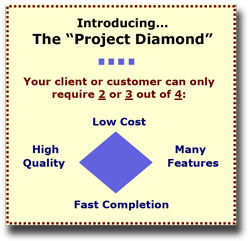Tips for Overcoming Project Overload
by Adele Sommers
It's two weeks before the deadline. But your
project is at least six weeks behind! Everyone is sweating
bullets. As the project leader, you're wringing your hands.
A volcano of surprises has erupted since the project
launched three months ago. And in
contrast to everyone's prognostications, no one foresaw
the lava flow of trouble ahead.
 Your dilemma: Information that was supposed
to be available in Week 2 won't be known for another
month. Parts of the system that were designed to work
one way are really working another. A key expert you needed
to provide critical details went on extended leave right
after the project launch. And that's just scratching
the surface! Your dilemma: Information that was supposed
to be available in Week 2 won't be known for another
month. Parts of the system that were designed to work
one way are really working another. A key expert you needed
to provide critical details went on extended leave right
after the project launch. And that's just scratching
the surface!
So today, that simple-looking undertaking that
your crystal ball said should only take four weeks of
work beckons from a distant horizon. The funding might
soon be cut off. And management will surely panic if
it's not finished for the scheduled unveiling.
You can sense disaster looming, yet everyone feels helpless. So, what can you do?
This article explains how to get out of "project
overload" and restore sanity to your endeavor.
It may be time to regroup and swiftly chart a new course.
But Wait! Couldn't You Try a Last-Minute,
Heroic Maneuver?
 Well, you could, but should you? Yes,
it's only human nature to want to pull out all the stops,
work 24/7, and pray that it will all come together. Is it
still possible to finish on time if you speed up your
efforts, put more people on the project, or require
the team to work 14 hours a day? And if you do, can
you ever get completely caught up? Well, you could, but should you? Yes,
it's only human nature to want to pull out all the stops,
work 24/7, and pray that it will all come together. Is it
still possible to finish on time if you speed up your
efforts, put more people on the project, or require
the team to work 14 hours a day? And if you do, can
you ever get completely caught up?
Let's get real. You and your team will probably
need to admit that there is no way you can achieve the original
goals in the expected time frame. There are just too
many loose ends. Key people and information sources
are missing, and that creates gaping holes. Further,
parts of the system aren't working correctly. How long
will it take to fix that?
A misconception about projects is that you can
remedy every late delay by adding people or increasing
effort. In certain cases, you can. In others, adding
people at the eleventh hour -- or working at a frenzied
pace -- just brings chaos, frustration, and errors.
A project delivered with major gaps will seem seriously
flawed if everyone compares it to the original plan.
Here's a powerful strategy that can make all the
difference...

It's
Time To Reframe Success!
Reframe success? What exactly does that mean?
Well, initially, you and your team defined a set of
requirements for completing the project. There were four types of criteria involved (some of which
may have been simply implied):
* Time (the speed or schedule for doing the
work)
* Cost (in terms of the funding, the resources,
or a combination)
* Quality (how well the effort needed to be done)
* Features (how many components or deliverables
there were, and how complex)
On this project, however, it seems you've run into
a common situation in which the features (and
perhaps quality) have collided with time.
There's too much to get done on too short a schedule. It's really
no one's fault; everyone was doing the best he or she
could. There were just too many dynamic variables in
play. When every aspect of a project is a moving target,
it often feels like skateboarding on molten rock.
If you reframe success, however, you can reset everyone's expectations toward a much more realistic set of goals.
Introducing the "Project Diamond"
 It's not unusual for project
sponsors or clients to want: It's not unusual for project
sponsors or clients to want:
1)
Low cost and
2) Fast completion and
3) High quality and
4) Many features in the final project deliverables.
Although
it's understandable to want the greatest value
for the funding, usually it is only possible to
achieve two or three out of four of these
goals on a typical project. If both the budget and schedule are fixed, the tradeoffs would have to limit the quality, constrain
the features, or both.
So the "disconnect" in the situation is
that you won't be able to complete everything you started
out to do per the original schedule. The answer: Re-plan the tail
end of the project so you can smoothly carry over
the unfinished tasks to a later phase. This will involve determining which tradeoffs can help you accommodate the severe limitations in the remaining schedule -- and will probably mean doing fewer things.
It's a lot like ending a meeting on time when you still
have unfinished business left on the agenda. Yes, everyone
can agree to continue talking until all topics have
been discussed. Or, you could choose to stop the meeting
gracefully by deciding what to carry over to
the next agenda. In fact, the earlier you can anticipate
any potential need to do this on your project, the more
your team and organization will benefit.
You Can Propose a Sanity-Saving Approach
 Here's a simple but effective strategy for
smoothly invoking a new contingency plan: Here's a simple but effective strategy for
smoothly invoking a new contingency plan:
Review and organize all tasks or deliverables into these categories:
- "Must-have" within the current
schedule, because they will be frequently used or high-impact items
- "Nice-to-have" within the current
schedule, but could be postponed
- Can't even schedule until there is more information available
Also, determine whether the stakeholders would consider receiving delivery:
- In phases, just in time for the deliverables' first dates of actual use, or
- As a pilot or series of prototypes to be tested first and refined later
With this technique, you and your client, management, and the project stakeholders have a flexible understanding of the priorities to be fulfilled -- as well as any tasks or deliverables that would need to be jettisoned or deferred as the project runs out of time.
In conclusion, by reviewing your reprioritized list with your team and management,
you can then make any changes needed. If you execute your plan
accordingly, you'll sleep soundly again at night!
©2009 Adele Sommers
|


